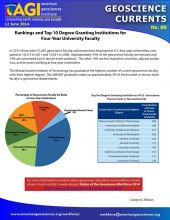A common assertion is that the number of geoscience degrees granted is dependent on the price of oil. However, this metric requires a response lag greater than oil price change velocity. A more responsive mechanism would likely be the rate of degree completion – that students would be incentivized to complete their geoscience degree by improved economic prospects.
Degree completion rates do show sensitivity to current events. The end of conscription in the US corresponds with a sharp decrease in completion rates and bachelor’s degree completion rates were sensitive to the stabilizing and eventual decline in oil prices in the 1980’s. The more recent rise in oil prices is not reflected in current completion rates, and likely corresponds to a decoupling of aggregate geoscience enrollments and oil price.
Degree completion rates and the price of oil.
Of note is how geoscience completion rates vary from other STEM fields. According to NSF, 59.4% of STEM bachelor’s candidates complete their degree, compared to 13% of geoscience bachelor’s candidates. Yet at the graduate level, STEM master’s candidates complete their degree within 10 years at a rate of 19%, and Ph.D.s at 9%, compared to the geoscience rates of nearly 20%. The geosciences see much lower completion rates than STEM fields at large at the undergraduate level, but are equal to superior in completion rates at the graduate level. Understanding the drivers for these differences require longitudinal analysis of degree recipients.







